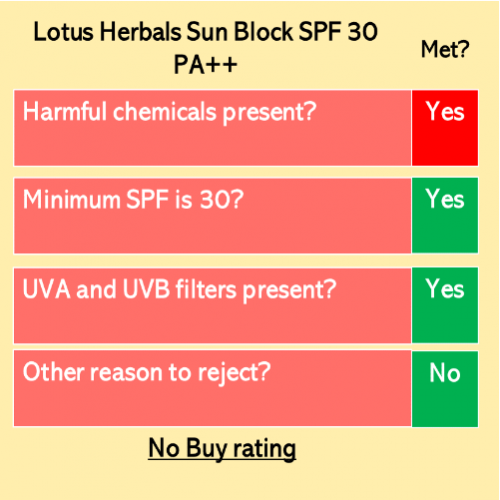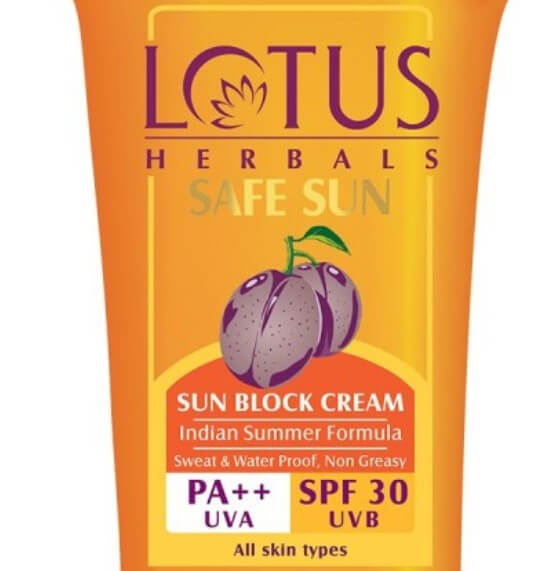
My view: Give it a miss
1. Harmful chemicals present?
The first set of harmful chemical present are parabens, which are cheap and effective preservatives. They are also estrogen mimickers and if you are thinking PCOS, then you are not the only one. The second harmful chemical is Oxybenzone, a UVA and UVB filter. This is also a hormonal disruptor and a known skin allergen.
(For more information, see Chemicals to Avoid – Parabens., Chemicals To Avoid – Benzophenone-3)
2. UVA and UVB filters are both present
Both UVA and UVB have both been implicated in skin cancer and photo-aging and we want filters to protect against both types of damage.
UVA filters protect against the damage caused by UVA radiation, which in a nutshell is photo-damage (wrinkles, hyper-pigmentation and loss of skin elasticity).
UVB filters protect mainly against UVB radiation, namely reddening of the skin (erythema), sunburn and skin-cancer. UVB/UVA filters combine the function of UVA and UVB filters.
2a) Has anything changed from SPF 20 to SPF 30?

The main UVB filter is Octyl Methoxy Cinnamate (or Octinoxate) which justifies the SPF 30 rating. Its also supported by Titanium Dioxide which is effective in the UVB region.
But that’s not what I want to highlight today.
2b) The UVA filter debacle
Lotus Herbals have chosen Avobenzone as its primary UVA filter. This is a gold standard UVA filter that is notoriously photo-unstable.
Available evidence shows Avobenzone degrades quickly upon exposure to sunlight, reducing its efficacy by as much as 50 and 90 per cent after 60 minutes of exposure.
This product uses Benzophenone-3 to stabilise this notoriously unstable UVA filter. Usually you’ll find multiple stabilisers in decent products, but let’s forgive Lotus Herbals for the moment.
Such generosity I hear you say. Well, the product by adding Octinoxate and Titanium Dioxide make Avobenzone photounstable. Also, Octinoxate becomes unstable in this combination.
The study listed below shows that a mixture of Octinoxate (Ethylhexyl methoxycinnamate) and Avobenzone shows less absorbance after UV exposure, indicating a photo-unstable formulation.
Therefore, having Avobenzone adds nothing to this product. Click on LINK for more information.
4. Other reasons to reject this product
India does not have specific sunscreen regulation – so manufacturer’s have a free hand over the labelling. Lotus Herbals have taken complete advantage and have ” SUN BLOCK”, “Sweat & Water Proof” on their label.
A sun block implies that the product completely blocks UVR (ultra violet radiation) or provides “complete” or “total” protection. Such a (miraculous) sunscreen does not exist and in other countries – where there is specific sunscreen regulation – manufacturers cannot make such claims.
Please pay no attention to these meaningless words.
See also: Top 5 sunscreen recommendations, Do You Understand The Gibberish On Sunscreen Labels?
Sources and uses:
US20170326062A1 (US Patent application pending),
US9956163B2 (Having previously been published, pre-grant publication)
Ceresole, R., Y.K. Han, M.A. Rosasco, et al., “Drug-Excipient Compatibility Studies in Binary Mixtures of Avobenzone,” Journal of Cosmetic Science, vol. 64(5), pp. 317-328, 2013. ;
Nash, J.F., and P.R. Tanner, “Relevance of UV Filter/Sunscreen Product Photostability to Human Safety,” Photodermatology, Photoimmunology and Photomedicine, vol. 30(2-3), pp. 88-95, 2014 ;
Wendy E Roberts, Lily I Jiang, and James H Herndon, Jr, “Facial primer provides immediate and long-term improvements in mild-to-moderate facial hyperpigmentation and fine lines associated with photoaging” Clin Cosmet Investig Dermatol. 2015; 8: 471–477.
